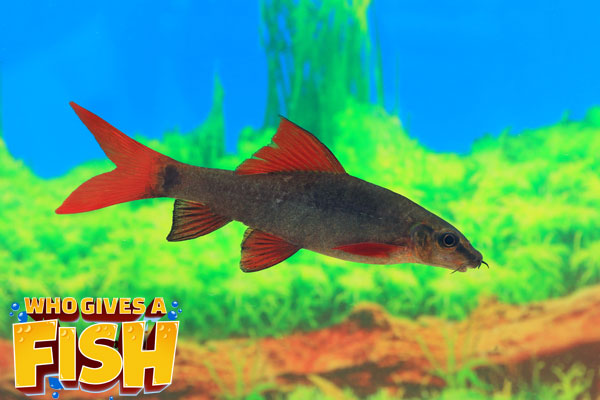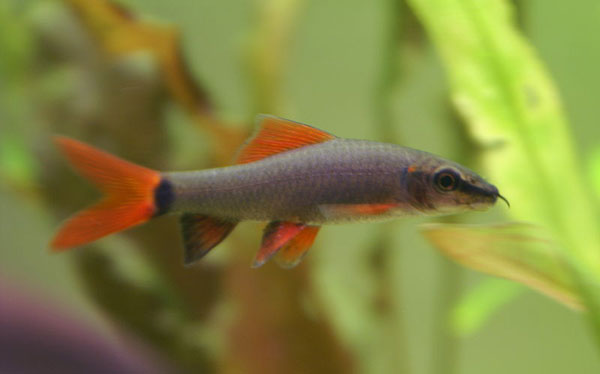Rainbow Shark
The rainbow shark, Epalzeorhynchos frenatus, is a favored freshwater fish that is associated to the Cyprinidae family. It is also known as whitetail shark minnow, ruby shark, whitefin shark, red fin shark, green fringelip labeo and the rainbow shark minnow. It is indigenous to the basins of Chao Phraya, Mekong, Maeklog and Xe Bangfai in Indonesia and Thailand. It is commonly found near any solid surface at mid water level, and the bottom depths in rivers and streams. It also moves into seasonally flooded habitats and returns to the rivers during the drier seasons.
- Experience Level: Moderate to Adavanced
- Hardiness: Moderate
- Minimum Tank Size: 55 G (208L)
- Maximum Size: 8.6 in (22 cm)
- Temperament: Aggressive
- Temperature: 75°F – 80°F (23.8°C – 26.6°C)
- pH Range: 6.5 – 7.5
- Water Hardness: 2 – 15 dGH
- Diet: Omnivore
Table of Contents
Introduction
Aquarium Setup
Feeding
Breeding and Social
It has a protracted body with a sharp snout and a forked tail. The body is dark-black and greenish in color with reddish fins. This particular species has an albino variety with bright orange fins and a white body. The abdominal area is flat and the eye and the mouth have a characteristic stripe.
The male rainbow shark has a brighter coloration and a skinnier body with dark black lines along the tail fin. Anal, pelvic and Dorsal fins are red with a slightly dusky black color. The dorsal fin contains up to 11 branched rays. The rainbow shark prefers water pH, water density and temperature that ranges from 6.5 to 7.5, 75°F to 80°F and 2 to 15 dH respectively. It feeds on periphyton, phytoplankton, zooplankton and algae. It can grow to around 22 cm in length and its life span can range from 5 to 8 years.
The rainbow shark was initially described by H.W. Fowler in 1943 and was placed in the genus Labeo under the species name frenatus. In 1998 the species was changed to the present genus Epalzeorhynchos by Winterbottom and Yang.
The Rainbow Shark not really a shark in the general sense, but actually belongs to the minnow family, Cyprinidae under order Cypriniformes of Class Actinopterygii. It has an upright dorsal fin that gives it a shark like appearance.
Aquarium Setup
A tank of at least 55 gallons or larger is recommended, and will need to be arranged with plenty of decor and plants. The tank should ideally have some decent room with plenty of hiding places such as plants, rocks and caves. The water pH of the tank should range between 6.5-7.5 while the water temperature should vary between 75°F and 80°F and water density should be kept between 2 to 15 dH. Ideally the rainbow shark should be housed on his own due to their territorial behavior towards same or similar species of fish.
A tight-fitting lid is highly advisable, as they are known to be terrific jumpers. This shark prefers well oxygenated and clean water with moderate water movement and a high level of dissolved oxygen.
Rainbow Shark Aquarium Guide
- Minimum Tank Size: 55 G (208 L)
- pH Range: 6.5 – 7.5
- Water Hardness: 2 – 15 dH
- Temperature: 75°F – 80°F (23.8°C – 26.6°C)
- Lighting: Any
- Substrate: Any
- Brackish: No
- Water Flow: Low to moderate
- Tank Region: Often hides around the bottom/middle, but will swim in all regions.
A young Rainbow Shark in a home aquarium – Source
Feeding
The rainbow shark is an omnivore and in the wild, it usually feeds on periphyton, zooplankton, phytoplankton and algae. In captivity, it primarily eats algae in the form of flacks, wafers and tablets. It also takes live food such as insect larvae, crustaceans, tubifex worms and aquatic insects. It should also be fed with brine shrimp, spinach, frozen bloodworms and lettuce. Feeding should be done 2-3 times per day.
Rainbow Shark Feeding Guide
- Diet: Omnivore
- Frequency: 2 – 3 times daily
- Pellet Foods: Yes (soak in water first to soften)
- Flake Foods: Yes
- Live Foods: Insect larvae, crustaceans, tubifex worms and aquatic insects
- Meat Foods: Brine Shrimp, frozen bloodworms
- Vegetable Foods: Lettuce, spinach
Breeding
It is extremely hard to identify at the juvenile stage accurately. Mature females have a noticeably harder body than the males. The males are much slimmer than the females, and have black lines along the anal fin.
Breeding sometimes occurs in the aquarium due to their aggression against their own species. It will reach maturity during the period between October-November. Both the male and female need to be at least 4 inches long to ensure maturity. It is an egg layer, and the spawning season depends on much cooler temperatures and day length.
To be able breed rainbow shark in captivity, a hormone injection is utilized. During spawning in captivity, a tank of 75 gallons or larger. During this time, the fish should be fed with protein rich food like tune or brine shrimp, and 25 % of the tank water should be changed using a bucket. The female lays her eggs on the aquarium gravel, and the male fertilizes them with a milt spray.
The eggs usually hatch after several days. After fertilization, the fry should be relocated to a 10 gallon fry tank with a mini heater and de-chlorinated water. The fry should be fed with liquid fry food for up to two weeks and then introduce them to baby brine shrimp. The fingerling should be relocated to their own tanks when they reach 1/2 to 1 inches in length. Juveniles need a lot of vegetation in their diet to prompt proper growth and coloration. Without a proper diet, their colors can fade and their growth can be stunted.
Social
Suitable tank mates include large tetras, catfish, fish like barbs and other fish of similar temperament such as gouramis, rasboras, loaches, rainbowfish, plecos and danios.
This particular fish can become combative with other, smaller fish in the tank that invades its territory. They should ideally be kept with at least 5-6 individuals to reduce any hyper dominance or aggression. They should not be kept with Red Tail Shark or other Rainbow Sharks.



